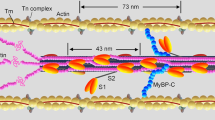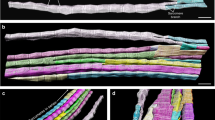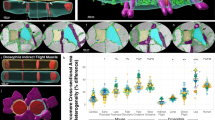Abstract
Production of active force in skeletal muscle results from the interaction of myosin-containing thick filaments with actiri-containing thin filaments. These muscles are also passively elastic, producing forces that resist stretch independently of ATP splitting or of interaction between the filaments. The mechanism of this passive elasticity is unknown; suggestions include gap filaments in the region between thick and thin filaments in muscles stretched beyond filament overlap1–5, or intermediate filaments which connect successive Z-disks6. Recently, the two exceptionally large proteins titin (also called connectin) and nebulin (originally called band 3) have been implicated in passive elasticity (for review see refs 7, 8). Here, we show that after these proteins are degraded by low doses of ionizing radiation, the ability of single skinned muscle cells to generate both passive tension in response to stretch and active tension in response to calcium is greatly reduced. These effects are accompanied by axial misalignment of thick filaments. Titin and/or nebulin apparently provide axial continuity for the production of resting tension on stretch and also tend to keep the thick filaments centred within the sarcomere during force generation.
This is a preview of subscription content, access via your institution
Access options
Subscribe to this journal
Receive 51 print issues and online access
$199.00 per year
only $3.90 per issue
Buy this article
- Purchase on Springer Link
- Instant access to full article PDF
Prices may be subject to local taxes which are calculated during checkout
Similar content being viewed by others
References
Carlsen F., Knappeis, G. G. & Buchthal, F. J. biophys. biochem. Cytol. 11, 95–117 (1961).
Huxley, A. F. & Peachey, L. D. J. Physiol., Lond. 156, 150–165 (1961).
Locker, R. H. & Leet, N. G. J. Ultrastruct. Res. 52, 64–75 (1975).
Magid, A., Ting-Beall, H. P., Carvell, M., Kontis, T. & Lucaveche, C. in Contractile Mechanisms in Muscle (eds Pollack, G. H. & Sugi, H.) 307–328 (Plenum, New York, 1984).
Sjostrand, F. S. J. Ultrastruct. Res. 7, 225–246 (1962).
Wang, K. & Ramirez-Mitchell, R. J. Cell Biol. 96, 562–570 (1983).
Maruyama, K. in Muscle Contraction: Its Regulatory Mechanisms (eds Ebashi, S., Maruyama, K. & Endo, M.) 485–496 (Springer, New York, 1980).
Wang, K. Cell Muscle Motil. 6, 315–369 (1985).
Maruyama, K., Kimura, S., Yoshidomi, H., Sawada, H. & Kikuchi, M. J. Biochem., Tokyo 95, 1423–1433 (1984).
Wang, K. & Williamson, C. L. Proc. natn. Acad. Sci. U.S.A. 77, 3254–3258 (1980).
Maruyama, K., Kimura, S., Ohashi, K. & Kuwano, Y. J. Biochem., Tokyo 89, 701–709 (1981).
Wang, K., Wright, J. & Ramirez-Mitchell, R. Biophys. J. 47, 349a (1985).
Wang, K., McClure, J. & Tu, A. Proc. natn. Acad. Sci. U.S.A. 76, 3698–3702 (1979).
Kempner, E. S. & Haigler, H. T. in Growth and Maturation Factors Vol. 3 (ed. Guroff, G.) 149–173 (Wiley, New York, 1985).
Kempner, E. S. & Haigler, H. T. J. biol. Chem. 257, 13297–13299 (1982).
Magid, A. & Law, D. J. Science 230, 1280–1282 (1985).
Podolsky, R. J. J. Physiol., Lond. 170, 110–123 (1964).
Mannherz, H. G. & Goody, R. S. A. Rev. Biochem. 45, 427–465 (1976).
Hanson, J., O'Brien, E. J. & Bennett, P. M. J. molec. Biol. 58, 865–871 (1971).
Atwood, K. C. & Norman, A. Proc. natn. Acad. Sci. U.S.A 35, 696–709 (1949).
Maruyama, K., Yoshioka, T., Higuchi, H., Ohashi, K., Kimura, S. & Natori, R. J. Cell Biol. 101, 2167–2172 (1985).
Trinick, J., Knight, P. & Whiting, A. J. molec. Biol. 180, 331–356 (1984).
Higuchi, H. & Umazume, Y. Biophys. J. 48, 137–147 (1985).
Maruyama, K., Sawada, H., Kimura, S., Ohashi, K., Higuchi, H. & Umazume, Y. J. Cell Biol. 99, 1391–1397 (1984).
Wood, D. S., Zollman, J., Rueben, J. P. & Brandt, P. W. Science 187, 1075–1076 (1975).
Somerville, L. L. & Wang, K. Biochem. biophys. Res. Commun. 102, 53–58 (1981).
Thames, M. D., Teichholz, L. E. & Podolsky, R. J. J. gen. PhysioL 63, 509–530 (1974).
Goldman, Y. E. & Simmons, R. M. J. PhysioL, Lond. 350, 497–518 (1984).
Hellam, D. C. & Podolsky, R. J. J. PhysioL, Lond. 200, 807–819 (1969).
Author information
Authors and Affiliations
Rights and permissions
About this article
Cite this article
Horowits, R., Kempner, E., Bisher, M. et al. A physiological role for titin and nebulin in skeletal muscle. Nature 323, 160–164 (1986). https://doi.org/10.1038/323160a0
Received:
Accepted:
Issue Date:
DOI: https://doi.org/10.1038/323160a0
This article is cited by
-
Predominant synthesis of giant myofibrillar proteins in striated muscles of the long-tailed ground squirrel Urocitellus undulatus during interbout arousal
Scientific Reports (2020)
-
Nanoscopic changes in the lattice structure of striated muscle sarcomeres involved in the mechanism of spontaneous oscillatory contraction (SPOC)
Scientific Reports (2020)
-
Deconstructing sarcomeric structure–function relations in titin-BioID knock-in mice
Nature Communications (2020)
-
A HaloTag-TEV genetic cassette for mechanical phenotyping of proteins from tissues
Nature Communications (2020)
-
Calcium-dependent titin–thin filament interactions in muscle: observations and theory
Journal of Muscle Research and Cell Motility (2020)
Comments
By submitting a comment you agree to abide by our Terms and Community Guidelines. If you find something abusive or that does not comply with our terms or guidelines please flag it as inappropriate.



